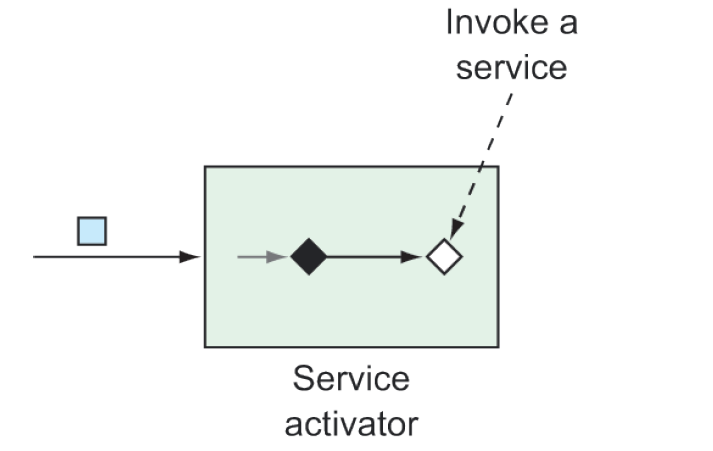10.2.6 Service activators
Service activators receive messages from an input channel and send those messages to an implementation of MessageHandler, as shown in figure 10.7.
 Figure 10.7 Service activators invoke some service by way of a MessageHandler on receipt of a message.
Figure 10.7 Service activators invoke some service by way of a MessageHandler on receipt of a message.
Spring Integration offers several MessageHandler implementations out of the box (even PayloadTypeRouter is an implementation of MessageHandler), but you’ll often need to provide some custom implementation to act as a service activator. As an example, the following code shows how to declare a MessageHandler bean, configured to be a service activator:
@Bean
@ServiceActivator(inputChannel="someChannel")
public MessageHandler sysoutHandler() {
return message -> {
System.out.println("Message payload: " + message.getPayload());
};
}The bean is annotated with @ServiceActivator to designate it as a service activator that handles messages from the channel named someChannel. As for the MessageHandler itself, it’s implemented via a lambda. Although it’s a simple MessageHandler, when given a Message, it emits its payload to the standard output stream.
Alternatively, you could declare a service activator that processes the data in the incoming message before returning a new payload, as shown in the next code snippet. In that case, the bean should be a GenericHandler rather than a MessageHandler.
@Bean
@ServiceActivator(inputChannel="orderChannel",
outputChannel="completeChannel")
public GenericHandler<EmailOrder> orderHandler(
OrderRepository orderRepo) {
return (payload, headers) -> {
return orderRepo.save(payload);
};
}In this case, the service activator is a GenericHandler that expects messages with a payload of type EmailOrder. When the order arrives, it’s saved via a repository; the resulting saved EmailOrder is returned to be sent to the output channel whose name is completeChannel.
You may notice that a GenericHandler is given not only the payload but also the message headers (even if the example doesn’t use those headers in any way). If you prefer, you can also use service activators in the Java DSL configuration style by passing a MessageHandler or GenericHandler to handle() in the flow definition as follows:
public IntegrationFlow someFlow() {
return IntegrationFlows
...
.handle(msg -> {
System.out.println("Message payload: " + msg.getPayload());
})
.get();
}In this case, the MessageHandler is given as a lambda, but you could also provide it as a method reference or even as an instance of a class that implements the MessageHandler interface. If you give it a lambda or method reference, be aware that it accepts a message as a parameter.
Similarly, handle() can be written to accept a GenericHandler if the service activator isn’t intended to be the end of the flow. Applying the order-saving service activator from before, you could configure the flow with the Java DSL like this:
public IntegrationFlow orderFlow(OrderRepository orderRepo) {
return IntegrationFlows
...
.<EmailOrder>handle((payload, headers) -> {
return orderRepo.save(payload);
})
...
.get();
}When working with a GenericHandler, the lambda or method reference accepts the message payload and headers as parameters. Also, if you choose to use GenericHandler at the end of a flow, you’ll need to return null, or else you’ll get errors indicating that there’s no output channel specified.
